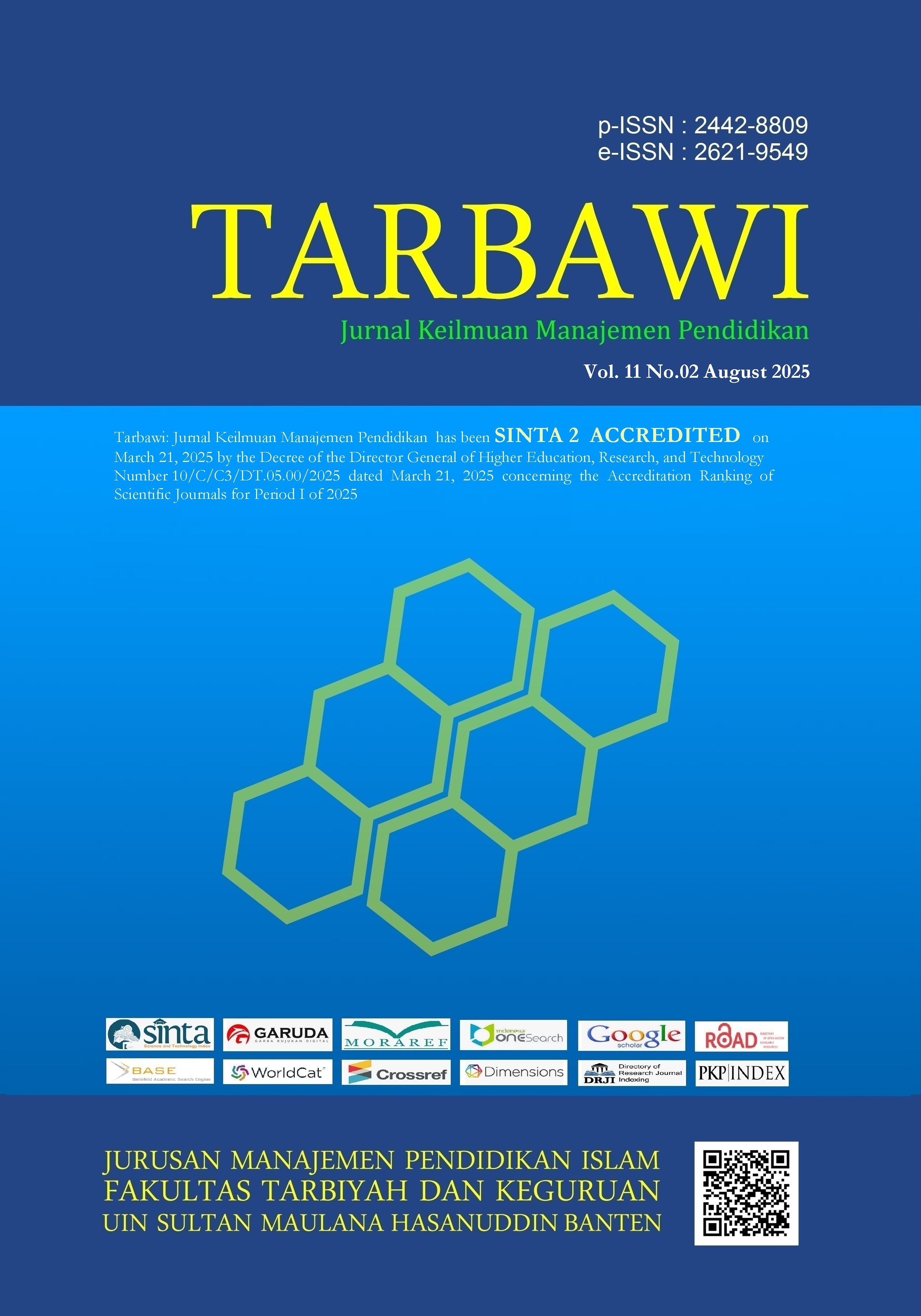Strategic Management of School Facilities and Infrastructure: A Case Study of State Elementary School 11 Sesetan Denpasar
 DOI:
DOI:
https://doi.org/10.32678/tarbawi.v11i02.11405
 Abstrak viewed : 190 times
|
Abstrak viewed : 190 times
|  PDF (English) downloaded : 95 times
PDF (English) downloaded : 95 times
Kata Kunci:
Digital inventory, Facility management, School infrastructureAbstrak
This study aims to analyse the planning, implementation, and evaluation processes of facilities and infrastructure management at State Elementary School 11 Sesetan Denpasar to support the creation of an effective, comfortable, and efficient learning environment. Employing a qualitative approach with a case study design, data were collected through direct observation, in-depth interviews with school stakeholders, and document analysis. The findings show that facilities planning is carried out systematically and collaboratively, involving teachers, school leaders, and committees. The school adopts a digital inventory system to optimise asset management, while regular evaluations are conducted monthly, semiannually, and annually to ensure continuous improvement. The study concludes that structured and participatory facility management contributes significantly to improving the quality of educational services and fostering a conducive learning atmosphere. These results offer practical implications for educational policymakers and school administrators in developing adaptive and innovative school facility management strategies in response to the evolving demands of basic education.
Unduhan
Referensi
Aulia, M. S. N. (2017). Manajemen Sarana dan Prasarana Madrasah. Jurnal Isema: Islamic Educational Management, 2(1)43-53. https://doi.org/10.15575/isema.v2i1.4996
Berliani, T., Wahyuni, R., & Lenny, R. (2021). Implementasi Supervisi Akademik dalam Rangka Peningkatan Profesionalisme Guru Masa Pandemi Covid 19 di SDN 5 Langkai Kota Palangka RayA. Equity in Education Journal, 3(1), 1-10. https://doi.org/10.37304/eej.v3i1.2447
Bo, N. S. W. (2025). OECD digital education outlook 2023: Towards an effective education ecosystem. Hungarian Educational Research Journal, 15(2), 284-289. https://doi.org/10.1556/063.2024.00340
Bryson, J. M. (2015). Strategic planning for public and nonprofit organizations. In International Encyclopedia of the Social & Behavioral Sciences: Second Edition (pp. 515-521). Elsevier Inc. https://doi.org/10.1016/B978-0-08-097086-8.74043-8
Bush, T. (2003). Theories of educational leadership and management. Sage.
Caldwell, B. J., & Spinks, J. M. (2013). The self-transforming school. Routledge.
Dahar, M. A., & Faize, F. A. (2011). Mis-allocation of student teacher ratio, class size and per student expenditure leads to the wastage of resources and lower academic achievement: an issue of resource management. International Research Journal of Finance & Economics, 62(3), 94-110. http://www.eurojournals.com/finance.htm
Fullan, M. (2016). The new meaning of educational change. Teachers college press.
Gamage, D., Adams, D., & McCormack, A. (2009). How Does a School Leader's Role Influence Student Achievements? A Review of Research Findings and Best Practices. International journal of educational leadership preparation, 4(1), 1-16. http://ijelp.expressacademic.org/
Herawati, S., Arafat, Y., & Puspita, Y. (2020). Manajemen pemanfaatan sarana dan prasarana pembelajaran. Attractive: Innovative Education Journal, 2(3), 21-28.
Hossain, M. (2022). Diffusing “destandardization” reforms across educational systems in low-and middle-income countries: The case of the World Bank, 1965 to 2020. Sociology of Education, 95(4), 320-339. https://doi.org/10.1177/00380407221109209
Huberman, M., & Miles, M. B. (2002). The qualitative researcher's companion. Sage.
Kartini, K., Sobar, A., & Karyaningtyas, K. (2023). Pengelolaan sarana dan prasarana pendidikan di sekolah. Thawalib: Jurnal Kependidikan Islam, 4(2), 115-123. https://doi.org/10.54150/thawalib.v4i2.238
Luthfiyah, A., Azzahra, N., Alghifari, A., & Kusumaningrum, H. (2025). Optimalisasi sarana dan prasarana untuk mendukung proses pembelajaran. Harmoni Pendidikan: Jurnal Ilmu Pendidikan, 2(1), 90-103. https://doi.org/10.62383/hardik.v2i1.1004
Mahdalina, M. (2023). Manajemen sarana prasaran pendidikan dalam proses pembelajaran anak Sekolah Dasar (SD) pada Kecamatan Sungai Tabukan Kabupaten Hulu Sungai Utara. SENTRI: Jurnal Riset Ilmiah, 2(12), 5423-5430. https://doi.org/10.55681/sentri.v2i12.1943
Marmoah, S., & Jenny Indrastoeti Siti Poerwanti, S. (2022). Literacy culture management of elementary school in Indonesia. Heliyon, 8(4), e09315. https://doi.org/10.1016/j.heliyon.2022.e09315
Mumtahana, H. A., Rudyanto, H. E., Pamungkas, R., & Pradana, L. N. (2022). Analisis kesiapan sekolah dasar di Kota Madiun pada proses pembelajaran daring. In Prosiding SENDIKO (Seminar Nasional Hasil Penelitian & Pengabdian Masyarakat Bidang Ilmu Komputer) (Vol. 1, No. 1).
Noorkhalis, M., Aslamiah, A., & Suriansyah, A. (2023). Implementation of Integrated Quality Management in Elementary Schools. International Journal of Social Science And Human Research, 6(01), 95-112. https://doi.org/10.47191/ijsshr/v6-i1-32
Pertiwi, D., Pramulia, F., Yantoro, Y., & Setiayadi, B. (2023). Analisis manajemen kurikulum di SDN 17/1 Rantau Puri Kabupaten Batang Hari. JIIP-Jurnal Ilmiah Ilmu Pendidikan, 6(8), 5779-5783. https://doi.org/10.54371/jiip.v6i8.2570
Rozak, F., Irawati, I., Hasgimianti, H., & Thahir, M. (2020). Inventory Management of Educational Facilities and Infrastructure at State Vocational High School 2 Pekanbaru. Tarbawi: Jurnal Keilmuan Manajemen Pendidikan, 6(01), 29-36. https://doi.org/10.32678/tarbawi.v6i01.2212
Salmiah, M., & Abidin, Z. (2022). Konsep dasar pengelolaan kelas dalam tinjauan psikologi manajemen. ITQAN: Jurnal Ilmu-Ilmu Kependidikan, 13(1), 41-60. https://doi.org/10.47766/itqan.v13i1.185
Siregar, N., & Aziza, S. (2021). Optimization of facilities and infrastructure management in improving the quality of learning. Jurnal Tarbiyah, 28(1), 30-43. http://dx.doi.org/10.30829/tar.v28i1.905
##submission.downloads##
Diterbitkan
Cara Mengutip
Terbitan
Bagian
Lisensi
Hak Cipta (c) 2025 I Dewa Putu Juwana , I Putu Eka Indrawan, Ni Luh Putu Yesy Anggreni

Artikel ini berlisensiCreative Commons Attribution-ShareAlike 4.0 International License.







.jpg)



